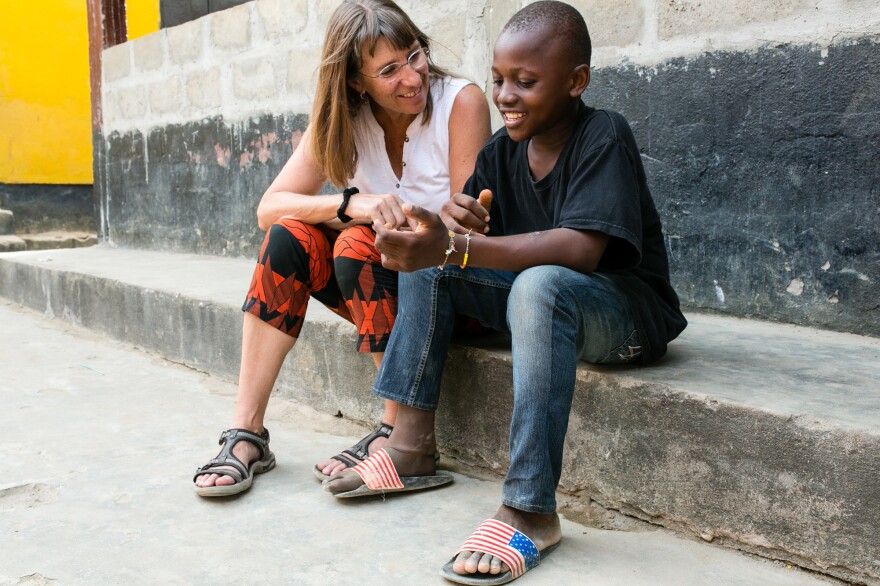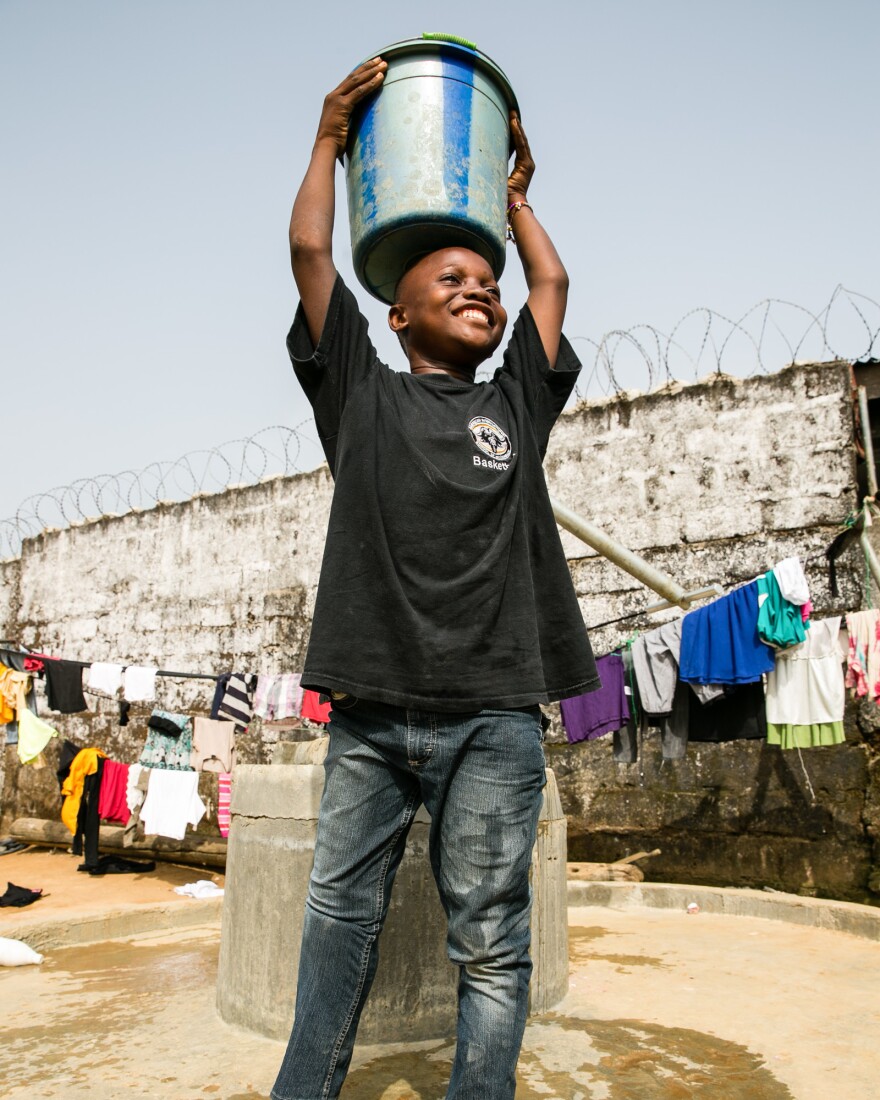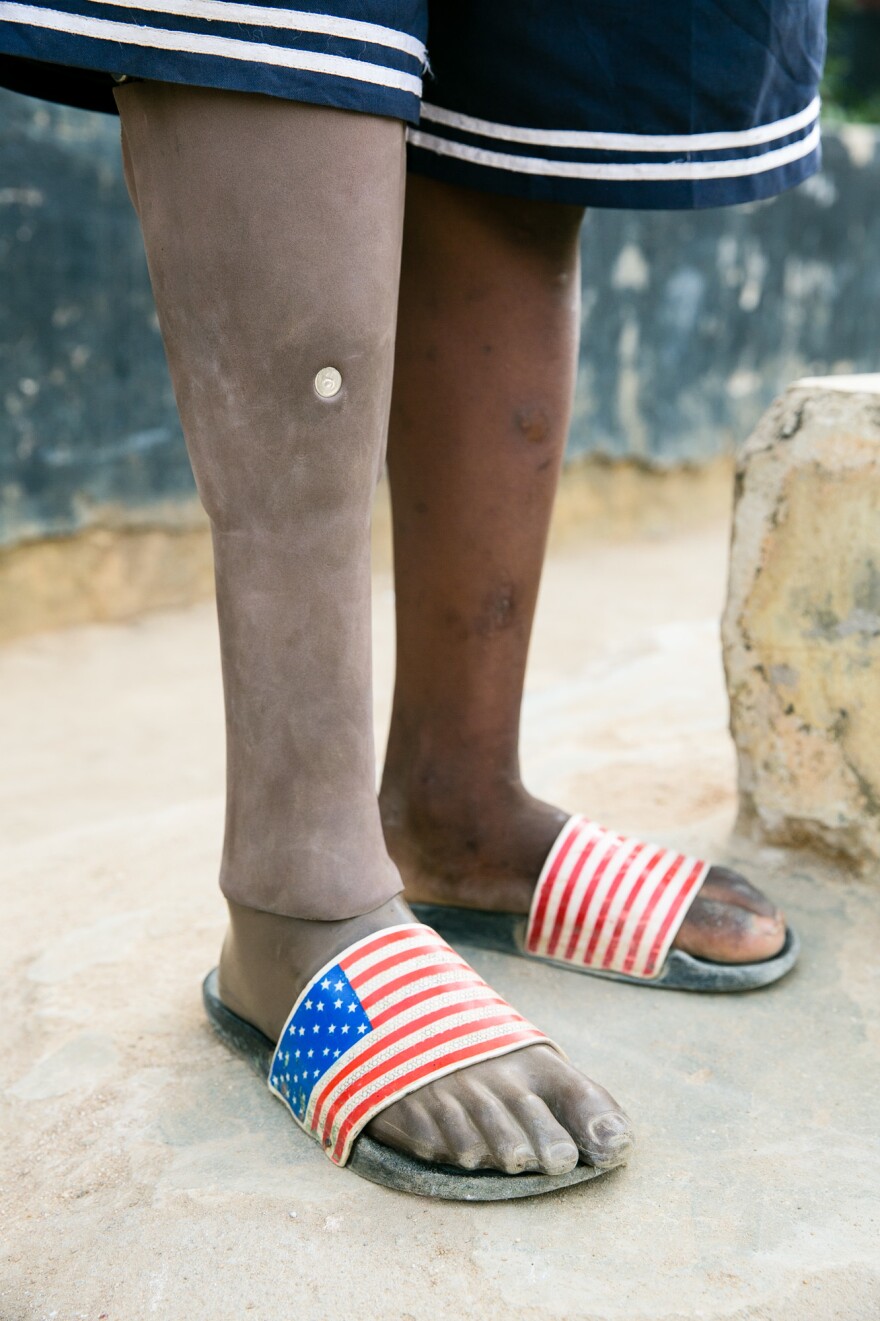The Children's Relief Ministry orphanage sits at the end of a dirt road in Paynesville, Liberia. There's no running water or electricity. Many of the 40 or so boys and girls who live there lost their parents in the country's civil war or to the more recent Ebola epidemic.
When Peace Corps volunteer Anne Geroski first showed up in August, CRM director Moses Kargbo suggested she get to know the kids. There was one who stood out immediately: a 12-year-old named Sundaygar Moses. At the orphanage, he's known as "the general," because he dashes around constantly, keeping tabs on everything that's going on.
They sat down to chat, and Sundaygar had two requests for Geroski. "The first thing he said to me is, 'I need a leg,'" Geroski remembers. "Then he said, 'I need a bicycle.'"

Yes, Kargbo confirmed, Sundaygar could indeed ride a bike. He'd figured out a way to do it, just as he had developed his own method to maneuver on a single crutch. Instead of putting the crutch under his armpit, he grips it at the top, like it's a cane. That way the crutch handle is reserved for his stump — which is all that's left of his right leg, where he was shot as an infant. It's hard to explain how this works, but it does, says Geroski, who soon learned that Sundaygar is also an avid soccer player.
"He's a kid who knows how to make things happen," she says.
And something very big happened recently: Sundaygar was fitted for a prosthetic and learned to walk without a crutch for the first time.
His reaction? "I felt fine," Sundaygar says, which Geroski explains means "really, really good" in Liberian English, especially among 12-year-olds.
It hasn't been an easy life for Sundaygar, starting with a traumatic gunshot wound at an early age. He spent the next few years at an orphanage that was eventually shut down. He arrived at CRM with a group of kids from that facility in 2010.
"When he first came he was suffering. He was skinny. You could tell by his condition he wasn't getting good care," says Abraham Cole, a 20-year-old who grew up at CRM and now helps out with the younger children. CRM feels like a family, Cole adds, with "the kind of love parents give you."
Sundaygar remembers, "There were children waiting for us, welcoming us." Although he looked different — Abe says most of them had never seen anyone with one leg before — they treated him the same. Sundaygar says he just watched the others until he eventually learned how to keep up.
Still, as Sundaygar told Geroski, he longed for a leg. The crutch was causing rashes under his arm, and even with this improvised method of walking, he had trouble doing certain tasks, such as drawing water from the well.

So Geroski added "prosthetic leg" to her ever-expanding list of needs she's discovered at CRM. They range from basic items, such as mirrors ("They don't even know what they look like," she says) to bigger asks, like a college scholarship for Abe.
She also mentioned the leg to her husband, Kevin Rodgers, a doctor who's teaching at the John F. Kennedy Medical Center in Monrovia.
The couple, who originally met as Peace Corps volunteers in Honduras in 1983, have remained committed to service. After raising four kids — including one who served in the Peace Corps in Peru and another who will head to Mozambique for the Peace Corps in April — they decided it was time to pitch in again.
Geroski, 56, an associate professor in the Graduate Counseling Program at the University of Vermont, is part of Peace Corps Response, which sends experienced professionals out on short-term assignments. Rodgers, 62, is stationed at the hospital as part of Peace Corps Global Health Service Partnership, a program for physicians and nurses to address health-care challenges.
For both of them, working with an orphanage was a priority. "In fact, Kevin asked if we could live in the orphanage," Geroski says. They couldn't, and both have other Peace Corps responsibilities in Liberia. But they devote as much attention to CRM as possible.
It's a special place, explains Rodgers, who is impressed by how well the kids are doing emotionally despite the conditions. Medically, however, there are red flags. "We have a to-do list we're working through," he says. All of the youngsters are behind on immunizations. Many have been malnourished in the past. Some have sickle cell anemia. Malaria is a constant concern. There are many, many cavities.
But there was no way to ignore Sundaygar — and his curious stump-crutch technique. Although it's remarkably effective, "he always seems to be on the verge of a crash," Rodgers adds.
So he was surprised when, one day in October, he saw Sundaygar running down the hallway of the hospital toward him. It was just a coincidence that they bumped into each other, and even more serendipitous was the fact that Rodgers happened to be in the middle of a meeting with a visiting surgeon from the MD Anderson Cancer Center in Houston.
Sundaygar had been brought to the hospital by Elizabeth's Legacy of Hope, a child amputee charity in the United Kingdom, and a charity called Street Child, which has a program focused on amputees. The assessment that day had ended with bad news: Sundaygar wasn't a candidate for a prosthesis unless he underwent surgery on his stump. After he was shot, the wound became infected; doctors removed his leg just a bit beneath his knee. A prosthetic that attaches below the knee requires a functional knee — and Sundaygar's isn't. So it looked as if he would need to have the knee removed.
Because of this run-in with a Texan specialist, Rodgers was able to get Sundaygar an instant second opinion. The new verdict: Get this kid a leg right now. It would be possible create an adapted prosthetic that allowed him to keep his knee, while using the knee of the prosthetic.

That's a project they could do on site, because the hospital is home to the Monrovia Rehabilitation Center. (It was established with the help of the nonprofit group Handicapped International but is now independent.) And because Rodgers and Geroski could handle coordination between the hospital and CRM, they told Street Child they would take over Sundaygar's case.
Orthopedic technician Forkpa Flomo constructed the leg out of metal, plastic and latex that were purchased by Elizabeth's Legacy of Hope. He then fine-tuned the fitting over the course of several visits. Ferrying Sundaygar to and from the hospital was Cole's job — it's a tricky multi-leg journey. First there's the 10-minute walk on the dirt road leading from the orphanage. The next step is getting a motorcycle for the short trip to Duport Junction, where it's possible to look for a taxi. Sundaygar and Cole then had to wait (sometimes over an hour) before embarking on the 30-minute drive into town and to the hospital.
Geroski and Rodgers were always at the entrance to meet them, and pay for taxi fees. (They also got Cole a cellphone, so they could stay in contact.) She viewed their role as "facilitators," who oversaw the process, held people accountable and kept everyone excited about moving forward quickly.
Sundaygar was soon learning how to use his new leg to take steps, then climb stairs. Eventually he went to the rehabilitation center's obstacle course, where he could test the leg out moving around in a gravel pit and on sawed-off logs. The toughest part? "The tires," Sundaygar says, because of the way they moved under him.
On December 7, he brought the leg home to the orphanage for the first time. Just like the day Sundaygar first arrived at CRM, there were kids waiting for him at the gate. Once again, he looked different. "Some thought it was a real leg, not a prosthetic," Abe says. (Flomo was able to closely match Sundaygar's skin tone.) There were several people crying, he adds, "They said, 'Finally the dream of Sundaygar has come to pass.'"
That's not the end of the story, by any means. Sundaygar is still adjusting to the new leg and strengthening the different muscles he needs to use it. He says when he wears it too long, he feels sore on his right side. He hasn't tried playing soccer with it yet.
"It slows him down at this point," Geroski says. But she has no doubt he'll speed up soon enough and go anywhere he wants.
In a country where there's a stigma for people with disabilities and amputees beg on the streets, Sundaygar is eager to chart his own course.
In fact, he's already decided on his career plans.
"Because I want to help people," he says. "I want to be a doctor that fixes legs."
Copyright 2021 NPR. To see more, visit https://www.npr.org.



